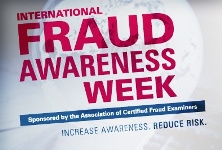4 Checklists That Could Save Your Company Money
/ AUTHOR’S POST
AUTHOR’S POST
Mandy Moody
ACFE Social Media Specialist
It sounds counterintuitive to say, “Happy Fraud Week” to my coworkers every year around this time, but I have to admit that I genuinely get excited for a week dedicated to sharing content and resources that ultimately strengthen the fight against fraud. Less fraud; more education: This, in fact, does make me happy.
This week has brought a multitude of tremendous supporters - more than 700 - to the forefront of the fight. From South Africa to California, I have seen seminars, conferences, white papers and more cross my screen over the past few days. We have had more than half a million tweets about International Fraud Awareness Week, and it’s only Thursday.
In the spirit of collaboration, I wanted to share with you some of the valuable “top” lists that I have seen light up on my dashboard this week:
- 13 Free Anti-Fraud Resources to Share with Your Employees or Company: Our FraudWeek.com website highlights resources, new and updated, for you to use to spread awareness.
- Cynthia Hetherington’s Four Tips on Minimizing the Impact of Fraud: The Hetherington Group reviews five steps businesses can take today to prevent fraud in the workplace. Bonus: Check out the five employee-monitoring controls.
- Top 10 Reasons to Authenticate Your Suppliers: Your employees are not the only people who could steal from you. These reasons make it imperative to check out your vendors and suppliers.
- Six Ways to Reduce the Risk of Fraud and Errors While Managing Spreadsheet Content: With more data comes more risk for error. Heed these tips so you don’t end up on the wrong side of a spreadsheet fraud.
Find more resources, highlights and coverage at FraudWeek.com. Also, http://www.twitter.com/TheACFE and search for #FraudWeek for real-time updates.

